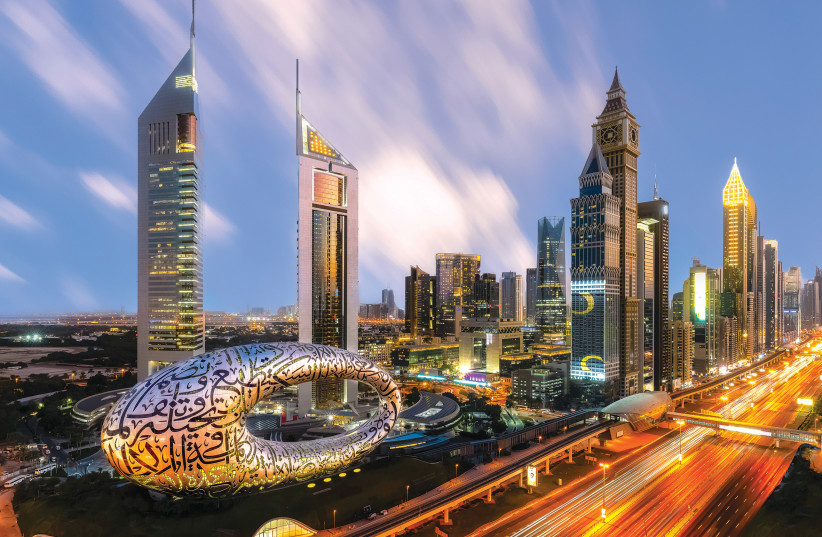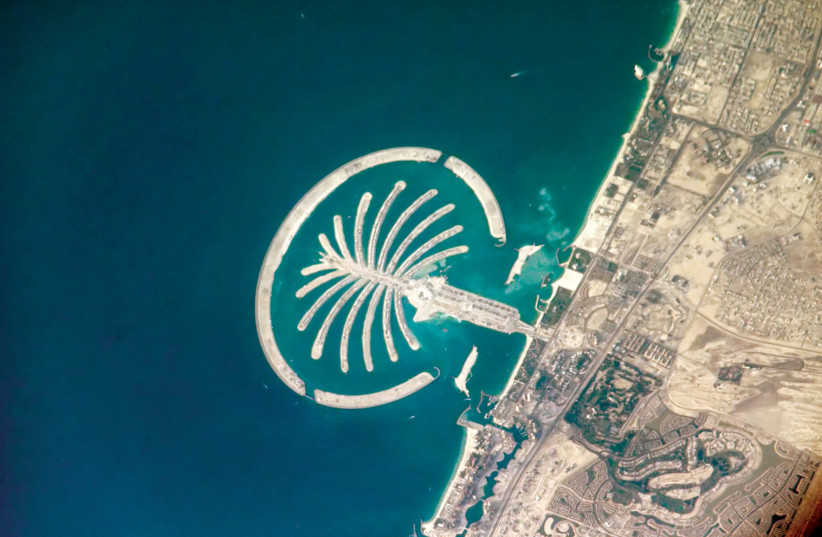Since the signing of the Abraham Accords in September 2020, Dubai, the largest city in the United Arab Emirates, has emerged as one of the top travel destinations for Israelis.
Post-corona numbers for visiting Israelis are expected to top a staggering 50,000 a month, although there will be a temporary lull over the summer months, when temperatures can soar to 40 degrees Celsius.
Since Saudi Arabia dropped its ban on flights to and from Israel using its air space, direct flights from Israel to Dubai now take just a little more than three hours, with four airlines to choose from.
Passengers landing at Dubai airport get a taste of what’s to come. The complex is vast, clean, quiet and super-efficient – in sharp contrast to the post-pandemic chaos at many international airports.
And another strange thing: there isn’t a local resident in sight, as all the staff are foreign workers. The same goes for the country’s hotel and service industry at every juncture. In fact, although Dubai has a population of almost 3.5 million, Emiratis make up only 12% of the population! The rest are foreign workers on temporary visas – the vast majority from Asia. In fact, there are more Indians (more than 40% of the population) in Dubai than Arabs. As a consequence, one hears a lot more English than Arabic.

Dubai is a bizarre mixture of tolerance and Bedouin, Islamic conservative tradition.
Many local men still wear the long white robes called kandurah, together with a white headscarf, ghutra. Their wives don black robes with a hijab head covering or the even more restrictive niqab. Homosexuality is banned and alcohol consumption is restricted.
Both the UAE (which comprises seven separate emirates, including Dubai) and Dubai itself are constitutional monarchies, without freedom of speech and a free press. Images of the ruler, Sheikh Mohammed bin Rashid Al Maktoum, are prominent, reminding visitors that despite the liberal atmosphere, Dubai is not a democracy.
On the other hand, Dubai is easygoing, almost entirely free of crime, spotlessly clean, and very safe. We saw no police or soldiers during our five-day visit.
Once you get over the initial culture shock you can begin to admire the sites, and Dubai has a lot to offer for such a small place.
A lot to offer in a small place
The most striking feature is the stunning skyline with futuristic skyscrapers and beautiful hotels dotted around the city, particularly along the coast and the Dubai Creek waterway, and along the massive 14-lane Sheikh Zayyad highway, which dissects the city.
Dubai is an architectural paradise with more skyscrapers than any other city in the world. The crème de la crème is the Burj Khalifa (Khalifa Tower), the world’s tallest building at 829.8 m (2,722 ft) high. The observation deck on floor 125, with stunning vistas of the city, is one of Dubai’s most popular attractions. A spectacular laser show lights up the tower at night, watched by thousands.
When you get tired of staring at the cascading skyscrapers you can indulge in a bit of retail therapy, and with more than 70 shopping centers, it’s no surprise that Dubai is dubbed the shopping center of the Middle East.
The most impressive is the Mall of Dubai, the world’s largest, bigger than 50 soccer fields. Along with all the main retail brands, the mall boasts an aquarium, an ice rink and a full-scale skeleton replica of a dinosaur!! The mind boggles, but that’s Dubai. Not to be outdone, a rival mall – the Mall of the Emirates – offers the world’s longest indoor ski slope with an accompanying chair lift.
Although Egypt and Jordan had already signed peace agreements with Israel, it was the US-brokered Abraham Accords that really marked the end of Israel’s regional isolation. It opened up the Arab world (Bahrain and later Morocco also joined the initiative), albeit still in a limited fashion. Israelis never really felt safe in Egypt and Jordan, where widespread hostility remains, and even though thousands of Israelis visit the Egyptian Sinai every month, security concerns remain.
Dubai is different. Hebrew can be heard at every attraction, and the Israeli tourists are warmly welcomed.
Informal ties between the two countries had existed for years, in part fueled by the perception of a common threat from Iran, which is situated close to the UAE, across the Strait of Hormuz in the Persian Gulf (also known as the Arabian Gulf). Military, intelligence and cybersecurity cooperation, much of it still classified, remain the cornerstone of the bilateral ties.
Drone and missile attacks on the UAE from Iranian-backed Houthi rebels in Yemen earlier this year underscored the need to foster the strategic relationship.
But such geopolitical considerations are of little concern to the average Israeli tourist, who relishes the opportunity to visit a destination that only a few years ago was off-limits.
The famed Israeli ingenuity and thinking out of the box is also apparent in Dubai.
Faced with a shortage of coastline, Dubai came up with a unique solution: Palm Island, the largest man-made island ever built, doubling Dubai’s coastline.

Only sand and rock was used in the construction in the shape of a palm tree surrounded by a circle, without any steel or concrete. The entire project took six years to complete, and today the archipelago is home to thousands of buildings and villas and 28 hotels with a monorail running the entire length.
Other highlights of the Dubai experience include dune bashing (hurtling up and down virgin sand dunes in a 4-by-4 jeep), a visit to the old city where Dubai began as a fishing and trading port, a visit to the traditional spice and gold markets, and the Dubai Frame, dubbed the biggest picture frame on the planet: a huge golden-color frame structure where visitors can take an elevator to the top for spectacular views of the old city on one side and the futuristic skyline of modern Dubai on the other.
Dubai has emerged as the region’s cutting-edge hi-tech, travel, financial and tourist hub, and is now attracting Israelis in droves. However, this could not have been achieved without the millions of foreign workers who built and continue to sustain the modern-day glittering metropolis.
The foreign workers know they can never be accepted as citizens, and if they lose their jobs will be deported. The best and the brightest – doctors, engineers and business people – can aspire for a golden visa which grants them a 10-year stay.
For the rest, Dubai certainly remains a better option to earn money than their impoverished homelands, but reports from rights groups have raised issues of exploitation and unfair labor practices. Tourists should realize that without cheap migrant labor, the Dubai dream would be unsustainable. ■
The author visited Dubai in May as part of a delegation of the Jerusalem Journalists Association.
